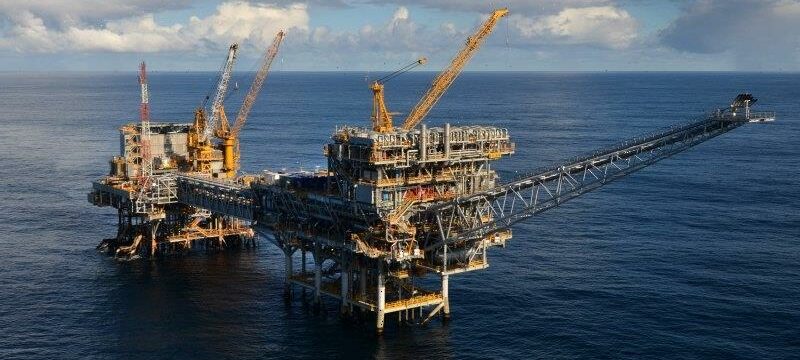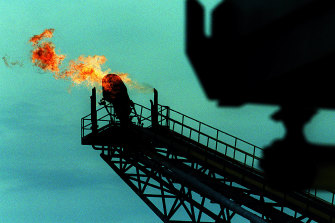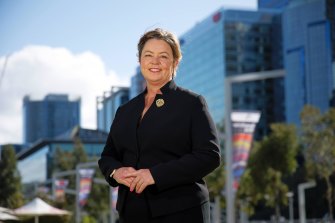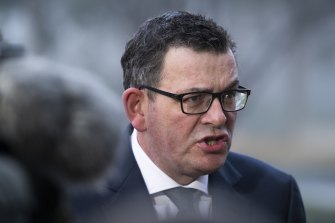Key points
- The Andrews government is considering a plan to offer local gas users first dibs on new on-shore gas extracted locally.
- However, the state government still favours a nationally consistent approach to the energy crisis, such as a domestic gas reserve.
- Victoria currently produces more gas than it uses but production is forecast to drop by 43 per cent by 2025.
Any new conventional on-shore gas extracted from Victoria would need to be offered to local gas users first, under a plan being considered by the Andrews government to tackle a looming supply crisis.
The state government has examined a so-called “domestic prioritisation mechanisation” under which Victorian gas users would get the “right of first offer” for any new Victorian gas projects, either in the Otway Basin or the Gippsland Basin.
Victoria’s gas reserves are currently all offshore in Bass Strait.Credit:James Davies
Although the state government has signalled it favours a nationally consistent approach to the energy crisis, such as a domestic gas reserve, Victoria is not ruling out taking unilateral action to shore up supply for local gas users.
A report by Ernst & Young into Victoria’s gas reserves suggests that introducing a domestic gas prioritisation plan would help shore up the state’s gas supplies. A state government source with knowledge of the matter said that the option had been considered, although a national version would be preferable.
It follows a dire warning from the Australian Energy Market Operator (AEMO) that the “legacy gas fields” that supply Victoria’s Longford Gas Plant will be depleted before next winter, prompting concerns about the state’s ability to cope with peak days next year.
Although Victoria currently produces more gas than it uses, AMEO predicts annual “existing and committed” Victorian production will drop by 43 per cent by 2025. It has warned this will reduce the system’s resilience to cope with unplanned outages or unexpectedly high electricity demand.
Federal Resources Minister Madeleine King wants the controversial Narrabri gas project to go ahead.Credit:Trevor Collens
“This tightening supply demand balance will result in an increased probability that operational issues are unable to be operationally managed, leading to an increased likelihood of threats to system security or curtailment events,” AEMO wrote in a recent assessment.
Federal resources minister Madeleine King last week told The Age and The Sydney Morning Herald that Victoria’s ban on fracking and coal seam gas extraction represented a significant barrier to solving the energy crisis. She has also warned Australia faces an even bigger energy crisis in the future unless it develops new gas fields, such as Narrabri project in northern NSW.
“It is difficult. Of course it is,” she said. “When you put a halt like that on potential exploitation of reserves for consumers and manufacturers, well, it’s clearly a pretty significant barrier.”
Premier Daniel Andrews said in response he would not jeopardise prime farming land by lifting the state’s ban on fracking. He claimed that there was “a very low likelihood that there are significant onshore conventional gas reserves” available in Victoria.
In 2012, Denis Napthine’s Coalition government placed a moratorium on all onshore gas exploration and development in Victoria. In 2017, the Andrews government passed legislation permanently banning fracking and coal seam gas extraction.
It also temporarily halted the exploration and development of onshore gas extracted using conventional methods. But this ban was lifted in July last year after a three-year study, leaving only the ban on fracking and coal seam gas extraction in place.
On Thursday, Andrews insisted the crisis had arisen not because of shortages of gas, but had rather arisen because Australia was exporting most its gas.
“There’s enough energy there,” he said. “It’s just about how it’s bought and sold, how it’s shared and spread across nations.”
Daniel Andrews isn’t ruling out state action to reserve gas for local households and businesses.Credit:Rhett Wyman
He said his preference was for a national domestic gas reserve policy, although he said he would not rule out a state-specific mechanism to ensure Victorian businesses and households could get the gas they need before it is exported.
The Andrews government insists that the key to solving the state’s energy crisis lies with continuing to invest in renewable energy.
Victorians use about 200 petajoules of gas annually, according to AEMO figures from March 2020.
Australia is one of the world’s largest exporters of gas. In 2019-20, it produced 5945 petajoules of gas, of which 4393 petajoules, or 74 per cent, went overseas. That left 1647 petajoules for domestic use, including power generation, heating and manufacturing, according to figures from the Department of Industry, Energy, Science and Resources).
Currently, all of Victoria’s gas comes from offshore gas fields in Bass Strait. But according to a government assessment – the result of the state’s latest airborne survey and thousands of rock samples collected from the Otway and Gippsland basins – the state could produce up to 830 petajoules of extra onshore conventional gas.
According to the Australian Competition and Consumer Commission Victoria’s current existing offshore basins hold a total of 2,768 “proved and probable” petajoules of gas in reserve.
That suggests the state’s reserves could be boosted by a maximum of about a third, over a timeframe of between five and 25 years. A March 2020 assessment provided to the state government by consultants Ernst & Young found the Otway Basin could produce a maximum of 715 petajoules of conventional gas.
But that would involve extensive exploration and development across the entire Otway Basin. It would also necessitate major investment in new processing facilities.
Under a “minimum scenario” it estimated an extra 90 petajoules of gas could be produced in the Otway region, requiring 18 exploration wells, 14 development wells and six discovery wells.
The potential additional gas supply in the Gippsland Basin is even more limited. The study found it could produce a maximum of 115 petajoules, requiring 70 exploration wells resulting in seven discoveries.
The Morning Edition newsletter is our guide to the day’s most important and interesting stories, analysis and insights. Sign up here.
Most Viewed in Politics
From our partners
Source: Read Full Article



